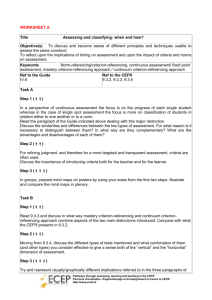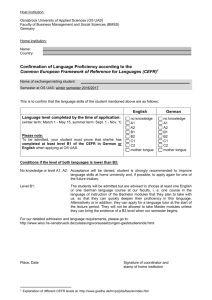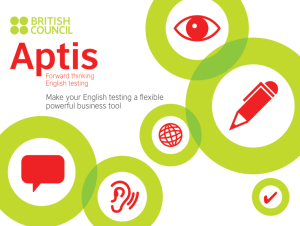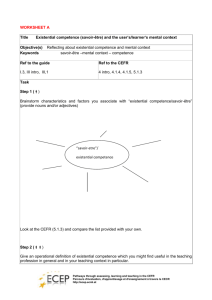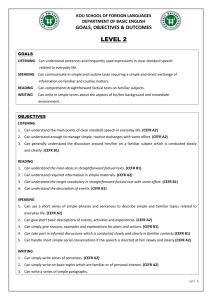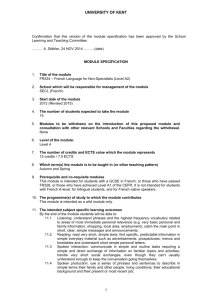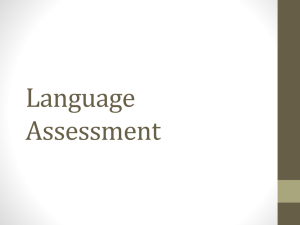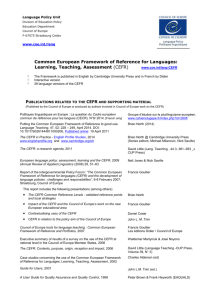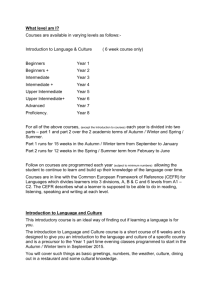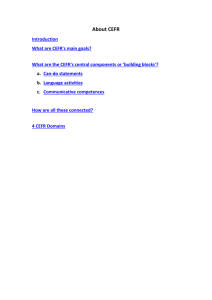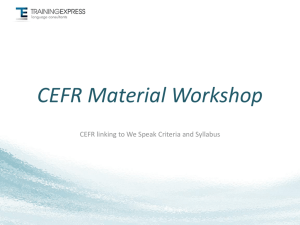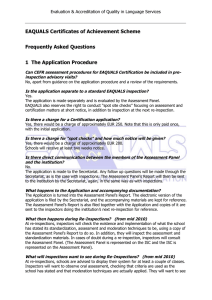Quality principles and basic concepts
advertisement
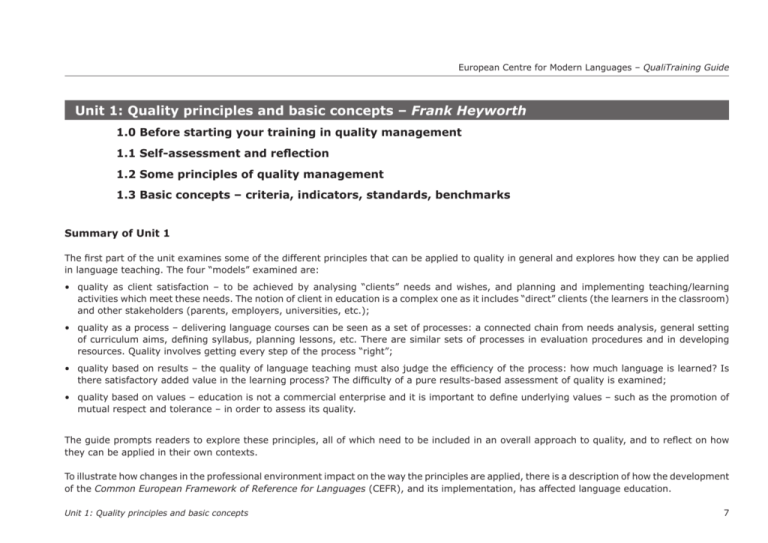
European Centre for Modern Languages – QualiTraining Guide Unit 1: Quality principles and basic concepts – Frank Heyworth 1.0 Before starting your training in quality management 1.1 Self-assessment and reflection 1.2 Some principles of quality management 1.3 Basic concepts – criteria, indicators, standards, benchmarks Summary of Unit 1 The first part of the unit examines some of the different principles that can be applied to quality in general and explores how they can be applied in language teaching. The four “models” examined are: • quality as client satisfaction – to be achieved by analysing “clients” needs and wishes, and planning and implementing teaching/learning activities which meet these needs. The notion of client in education is a complex one as it includes “direct” clients (the learners in the classroom) and other stakeholders (parents, employers, universities, etc.); • quality as a process – delivering language courses can be seen as a set of processes: a connected chain from needs analysis, general setting of curriculum aims, defining syllabus, planning lessons, etc. There are similar sets of processes in evaluation procedures and in developing resources. Quality involves getting every step of the process “right”; • quality based on results – the quality of language teaching must also judge the efficiency of the process: how much language is learned? Is there satisfactory added value in the learning process? The difficulty of a pure results-based assessment of quality is examined; • quality based on values – education is not a commercial enterprise and it is important to define underlying values – such as the promotion of mutual respect and tolerance – in order to assess its quality. The guide prompts readers to explore these principles, all of which need to be included in an overall approach to quality, and to reflect on how they can be applied in their own contexts. To illustrate how changes in the professional environment impact on the way the principles are applied, there is a description of how the development of the Common European Framework of Reference for Languages (CEFR), and its implementation, has affected language education. Unit 1: Quality principles and basic concepts 7 European Centre for Modern Languages – QualiTraining Guide The second part of the unit presents some of the basic concepts related to quality assurance: how do we establish criteria and use these to set standards? What indicators can we use to find out if we are achieving quality? How can benchmarking help us in this work? Again the concepts are applied to the readers’ own environment. 1.0 Before starting your training in quality management Reflective task 1 This reflective task is intended to help you to relate the theme of the workshop to your professional environment. Putting quality management into practice does not take place in a vacuum. It is affected by a variety of factors – ministry of education edicts, the availability of time and money, public pressure, the attitudes of parents, colleagues and students. Some of these are favourable to applying quality, some work against it. A starting point for our exploration of “qualitraining” will be to share awareness of some of these factors. A. Positive factors for quality initiatives Public attitudes (especially to language learning) 8 Ministry policy Teacher training Availability of resources Other factors Unit 1: Quality principles and basic concepts European Centre for Modern Languages – QualiTraining Guide B. Negative factors for quality initiatives Public attitudes (especially to language learning) Ministry policy Teacher training Availability of resources/expertise Other factors Try to be as specific as possible in describing the factors which affect quality in your environment. Would you say that your professional environment is generally favourable to the development of quality in language education? Or the opposite? Reflective task 2 The QualiTraining guide aims to help people who work in language education to set up systems for improving quality. In order to put into practice the ideas we present, you will need to take quite a lot of decisions – this will not be new to you, as everyone in teaching takes decisions every day – planning what to do in lessons, dealing with learners’ problems, deciding on how fast or how slowly to cover a particular part of the programme. All these can be described as “managing” quality. Managerial decisions – including those related to quality management – need to be taken at all levels in an institution. Unit 1: Quality principles and basic concepts 9 European Centre for Modern Languages – QualiTraining Guide (a) Have a look at the table1 below and reflect on the management (or management-related) responsibilities you have in your present job. At which of the three levels are you generally involved in decision taking? Level Decisions By whom? About what? 1. Strategic planning Curriculum developers, school directors, ministry of education officials Goals and strategies for attaining them. Policy decisions – defining aims for language education, producing curricula, allocating resources 2. Management control Heads of departments, teacher trainers, teachers 3. Operational control Heads of departments, teacher trainers, teachers Broad or narrow? Broad. The general nature of activities to be undertaken Timescale? Frequency? Policy for next decade. Plans for between one and five years Occasional Medium. Could be Translating strategy into organisational involved in either practice – deciding on a training programme, producing a syllabus on the basis of the curriculum Next week, next month or the next year or two Weekly, monthly, yearly Using checklists, following procedures to ensure teaching and other activities are carried out effectively and efficiently From “the here and now” to next week/ month Mainly day-to-day Largely concerned with day-to-day activities (b) What are your expectations from QualiTraining in relation to your current or future responsibilities and role in your institution/ department? Make a brief note of these and discuss them with a partner. 10 Unit 1: Quality principles and basic concepts European Centre for Modern Languages – QualiTraining Guide Unit 1 This unit provides an opportunity to consider the principles behind quality management and some of its basic concepts. In order to discuss quality it is first important to be able to define and describe quality. 1.1 Self-assessment and reflection What does quality mean to you personally? Think of daily transactions, events, purchases, meetings, etc. What makes you think “that was good”, or the opposite? What does quality mean in your profession – as a teacher, a trainer, a manager? What rationale enables you to say: that was a good lesson; it is an effective school; what an enriching learning experience. Please note that illustrations are merely suggestive of where the text would benefit from illustrative input. If you are using the guide in a training environment use the self-assessment exercise – first individually, then in pairs, then in groups of four, then the whole group. The aim is to get consensus on a formulation of the “commitment to quality”. Try and express for yourself your commitment to quality in your job. “For me quality means …”. Unit 1: Quality principles and basic concepts 11 European Centre for Modern Languages – QualiTraining Guide 1.2 Some principles of quality management In order to set up a system of quality management, you need to be familiar with different theoretical models of what quality is and how it can be achieved. Among the models frequently applied to quality are: Who are the clients in the education systems you work in: children, parents, future employers, higher education, the state? Think about who are the clients in your working situation. Are they direct, indirect, internal, external? A client satisfaction principle – quality is achieved when customer needs are met, when client expectations are exceeded. To do this you need to: Think about yourself as a client. Who provides services for you? What needs and wishes should they satisfy to provide a high quality service? identify your client. This is quite complex – the person who “consumes” the service is often different from the one who is paying for it, so you have direct and indirect clients. Some people who work in an institution do not have direct contact with external customers but provide services for their colleagues – who are internal clients. 12 Unit 1: Quality principles and basic concepts European Centre for Modern Languages – QualiTraining Guide What are the processes involved in producing a sequence of language lessons? Fill in some of the other components of the process of course delivery. A process model of quality – quality involves analysing all the processes involved in delivering a service – for example, a language course – and making sure they are produced efficiently. Processes can be divided into three phases – planning, implementation and outcome. In industry the objective is to achieve zero tolerance of error and a slogan for process management is “get it right, the first time, every time”. Quality based on results – one way of defining quality is based on results – in tests and examinations, for example. The principle is that unless you can prove the effectiveness of educational activity by measurable results, you cannot claim quality. Education systems have both stated values and implicit values in national curricula; institutions can have stated values in documents such as mission statements, but also unstated values which govern how people think and act, and how they judge whether quality is being achieved. Unit 1: Quality principles and basic concepts Planning Implementation Outcomes Setting learning objectives Presenting and explaining language Testing progress Choosing materials Managing activities Assessing achievement What are the advantages and disadvantages of using examination and test results as indicators of quality? Can you think of other bases for measuring results of learning/ teaching activities? 13 European Centre for Modern Languages – QualiTraining Guide Quality based on personal development – in this model quality is based on the motivation, the attitudes and skills of the people involved. In order for it to help maintain and improve quality, the institution needs to establish an environment which enables staff to develop and co-operate. This can be through staff development programmes, action research, peer observation, encouragement of innovation, quality circles. It implies an open style of leadership, with room for individual responsibility and initiative. Value-driven quality. Education is not just a mechanical industrial process, but embodies and tries to communicate values. The work of the Council of Europe in language learning seeks to promote plurilingualism as an instrument of tolerance and respect for other ways of life and other values. The present programme of the ECML is Languages for social cohesion. 14 Describe – from your own professional experience – good practice in creating a working environment which promotes quality. What are the explicit values which affect quality in your working environment? What are the unstated ones? What specific values might (or should) be specific to language teaching and learning? Unit 1: Quality principles and basic concepts European Centre for Modern Languages – QualiTraining Guide The Common European Framework of Reference for Languages (CEFR)2 and its influence on quality in language education The CEFR is a major development in language teaching and learning. It has contributed to the setting of common standards for establishing goals and measuring achievement; it states values to be considered in deciding on curricula and approach; and it offers a conceptual framework for teaching, learning and assessment. Its impact can be seen in the way in which it influences our application of the quality principles we have described. Quality based on client satisfaction – the CEFR provides a much more detailed basis for defining clients’ needs. The self-assessment grid (CEFR, Table 2, p. 26) and the prominence given to selfassessment as an instrument for successful learning provide a basis for clients to express what they can already do and what their objectives are. The introduction (CEFR, p. 4) defines many of the features of needs analyses: “Language learning activities are based on the needs, motivations, characteristics of learners: What will they need to do with the language? What will they need to learn in order to do what they want? What makes them want to learn? What sort of people are they? What knowledge, skill and experiences do their teachers possess? What access do they have to resources? How much time can they afford to spend?” The table analysing the external context of language use (CEFR, Table 5, p. 48) describes personal, public, occupational and educational domains and the situations in which learners will use the language. Above all, the simple positive language of the scales and “can do” statements makes talking about needs and wishes accessible to the ordinary learner. 2 Council of Europe (2001). Unit 1: Quality principles and basic concepts 15 European Centre for Modern Languages – QualiTraining Guide Quality as a process – process-oriented teaching and learning require detailed description and analysis; the CEFR’s coherent system of level descriptors enables schools and curriculum designers to make learning programmes which have a logical progression and where each step builds on the previous one. The scales describe the competences needed to learn languages and the activities language users carry out. The underlying process of language learning is described: “ability to put competences into action in the production/reception of spoken utterances/ written texts to express and understand meanings, to interpret and negotiate meaning in context and to engage in communicative activities.” The CEFR provides the conceptual categories on which processes can be defined and set up. Results-based quality assurance is made much easier by the existence of the levels and the scales. Clear and detailed objectives can be set and approaches to assessing proficiency reliably have been established. They make it possible to compare achievement in different languages in different contexts with a shared vocabulary and in meaningful language which everyone can understand. There is a growing body of evidence that awareness of objectives and self-assessment contributes to improved learning success and progress. Quality and values – the CEFR suggests values relevant to language learning, for example: “To promote mutual understanding and tolerance, respect for identities and cultural diversity through more effective international communication” (CEFR, p. 3). “To promote methods of modern language teaching which will strengthen independence of thought, judgment and action, combined with social skills and responsibility” (CEFR p. 4). It suggests that aims of this kind are relevant to exercising democratic citizenship and to promoting social cohesion. 16 Unit 1: Quality principles and basic concepts European Centre for Modern Languages – QualiTraining Guide Conclusion – the different models are not mutually exclusive, and in most environments are all present in some way. Achieving quality will never be static, but will be influenced by changes in the environment. The CEFR is one example of the way in which changes in the context of work can influence the way we implement quality processes. Thus, quality management will involve adopting a model which combines application of the different principles. Below is one example of such a model3: This model includes all the four principles we spoke of – the customers, process management, results and the development of values (through the “Society results”). 1.3 Basic concepts – criteria, indicators, standards, benchmarks 3 EFQM (2002). Unit 1: Quality principles and basic concepts 17 European Centre for Modern Languages – QualiTraining Guide Putting the principles into practice involves: deciding on the criteria to be applied to quality in the context of your activity. Any quality initiative begins with asking oneself questions like: Are we teaching effectively? Does the curriculum provide the right framework? Are we using our resources efficiently? Do we enable each individual student to achieve his/her full potential? when we ask these questions we are assuming criteria for good language teaching which might include features such as: effective teaching methods providing opportunities for learners to communicate in the foreign language; a transparent curriculum framework with clear learning objectives; efficient use of resources to contribute to optimal learning; individualised support for all learners; in order to answer the questions we need to collect data – on examination results, on the components of the curriculum, on our resources and how we use them, on the amount of individual help learners receive; if we want to make the data useful, we need to choose indicators, data which can be measured, which will allow us to compare our performance with others and enable us to take decisions on action we can take to improve what we do. For example, a common indicator for learning progress could be examination results, or standardised test results. 18 Unit 1: Quality principles and basic concepts European Centre for Modern Languages – QualiTraining Guide Examination results 65% of students pass public examination x at the end of the school year 35% of students fail This information is not very useful to us unless we can compare it with other performances in the same context; if the average pass rate is 80%, then we are doing badly, if it is 40% we are doing well (at least in comparison with others). On the basis of the evidence provided by the data we have collected, we can set standards – a definition of the operational objectives we set in order to meet the criteria and the ways in which we will assess our performance. One way of setting standards is to use benchmarking, identifying what is considered a best possible performance and setting this as a goal by which we measure if we are doing well or not. Benchmarking can be internal – for example, identifying the best practice within a school or institution and taking steps to ensure that everyone adopts this – or external – identifying another institution which represents best practice and adopting their standards of best practice as a model and as the touchstone by which we will measure our own achievements. The CD-Rom has examples of indicators and standards used in language education in different contexts and countries. Unit 1: Quality principles and basic concepts 19 European Centre for Modern Languages – QualiTraining Guide Apply the concepts of criteria, standards, indicators and benchmarking to your own professional context. Classroom teaching Criteria – for example, active, learner-centred, communicative Indicators – for example, amount of learner talk compared to teacher talk Standards – for example, regular class observations verifying varied use of different classroom formats – group and pair work, etc. Benchmarking – for example, identification of good practice through class observation. Setting this as the goal for common standards. 20 Unit 1: Quality principles and basic concepts European Centre for Modern Languages – QualiTraining Guide Do the same for other aspects of quality management of language teaching and learning. For example: student achievement; services to students; staff training; curriculum and syllabus planning; safety in the school; assessment and testing. Unit 1: Quality principles and basic concepts 21
